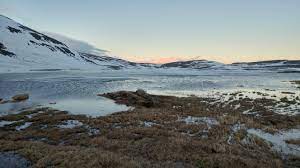Imagine the tundra as a fragile masterpiece, intricately woven by nature’s hand over centuries. Yet, amidst its stark beauty lies a story of looming threats that jeopardize its existence. From the subtle shifts in climate patterns to the encroaching human footprint, the tundra faces a battle for survival. Dive into the complexities of environmental and human-induced perils that test the resilience of this icy expanse, and uncover the urgent need for action to safeguard its future.
Climate Change Impact on Tundra
Climate change significantly alters tundra landscapes and species compositions, impacting the delicate balance of this harsh biome. Warming temperatures in the tundra lead to the growth of shrubs, which can have detrimental effects on species like caribou by altering their habitats and foraging grounds. This shift in vegetation can destabilize ecosystems, as it disrupts the traditional plant-animal interactions. Additionally, the increased shrubbery raises the risk of wildfires in these regions, further threatening the already fragile tundra ecosystems. The changing climate influences species compositions, favoring certain plants over others and potentially displacing native flora and fauna. These alterations can have cascading effects on the entire tundra ecosystem, as each species plays a crucial role in maintaining the intricate balance of this environment. Therefore, the impact of climate change on tundra ecosystems goes beyond just temperature changes; it encompasses a complex web of interactions that shape the future of these unique landscapes.
Human Activities Disrupting Tundra
Human activities are significantly disrupting tundra ecosystems through various industrial practices and land use changes. Permafrost degradation, caused by activities like resource extraction and infrastructure development, releases greenhouse gases, accelerating climate change. This thawing permafrost alters the landscape, impacting wildlife habitats and leading to biodiversity loss. Habitat destruction due to oil drilling, mining, and transportation infrastructure fragments tundra areas, affecting species that rely on vast, undisturbed spaces for survival. Resource extraction activities not only directly disturb the land but also contribute to pollution impacts, contaminating soil and water systems vital to tundra ecosystems. The extraction of natural resources further exacerbates the sensitivity of tundras to disruptions, intensifying the effects of climate change. To mitigate these disruptions, it is crucial to regulate industrial activities, implement sustainable land use practices, and prioritize conservation efforts to safeguard the fragile balance of tundra environments.
Air Pollution Threats to Tundra
Air pollution poses a significant threat to tundra ecosystems, impacting both the environment and wildlife populations. The effects of pollutants on the delicate balance of the tundra can be far-reaching. Here is a breakdown of the key impacts:
| Impact of Pollutants | Details |
|---|---|
| Snow Reflectivity | Reduced by black carbon settling on snow, leading to less sunlight reflection and increased absorption of heat. |
| Ozone Depletion | Chemicals causing ozone depletion allow stronger UV rays to penetrate, potentially harming both flora and fauna. |
| Lichen Health | Air pollution can harm lichen, an essential food source for many tundra animals, disrupting the food chain. |
| Cloud Formation | Arctic clouds are sensitive to air pollution, affecting cloud formation and potentially altering precipitation patterns. |
Understanding the intricacies of these impacts is crucial for developing effective strategies to mitigate the threats posed by air pollution to tundra ecosystems and the diverse wildlife that call them home.
Industrial Impact on Tundra Ecosystems
Industries operating in tundra regions have a direct impact on the delicate ecosystem through various activities such as drilling, mining, and construction. These activities contribute significantly to permafrost degradation, leading to thawing and subsequent greenhouse gas emissions. Soil contamination is another critical issue resulting from industrial operations, affecting the overall health of the tundra environment. Habitat destruction due to infrastructure development further exacerbates the vulnerability of tundra species, increasing the risk of biodiversity loss. Vegetation disturbance caused by heavy machinery and land clearing disrupts the intricate balance of plant communities, impacting the entire ecosystem. The industrial footprint on tundra ecosystems highlights the urgent need for sustainable practices and stringent regulations to mitigate these harmful effects. Conservation efforts must focus on minimizing permafrost disruption, preventing soil contamination, preserving habitats, safeguarding biodiversity, and minimizing disturbances to vegetation for the long-term health of tundra ecosystems.
Invasive Species in Tundra
In the Arctic tundra, the introduction of invasive species poses a significant threat to the native flora and fauna. Invasives can outcompete local species, leading to biodiversity loss and impacting ecosystem resilience. To understand the implications better, let’s delve into a comparison table showcasing the impact of invasive species in tundra ecosystems:
| Impact of Invasives | Species Competition | Biodiversity Loss |
|---|---|---|
| Disrupt native habitats | Compete for resources | Decrease species richness |
| Alter ecosystem dynamics | Drive native species out | Impact food chains |
| Reduce genetic diversity | Lead to population decline | Disrupt ecological balance |
Managing invasive species in the tundra requires proactive strategies. Monitoring and controlling their spread, restoring native habitats, and implementing policies to prevent further introductions are crucial steps. By addressing these challenges, we can safeguard the delicate balance of the tundra ecosystem and protect its unique biodiversity.
Wildlife Threats in Tundra
Wildlife in the tundra faces a multitude of threats stemming from environmental changes and human activities. Overgrazing effects by animals like lemmings and caribou disrupt the balance of plant and animal life, leading to food scarcity for other species. Pollution, particularly from oil spills, poses a significant threat to the survival of aquatic animals in the tundra. Resource exploitation contributes to the decline in Arctic fox populations, primarily due to excessive hunting for fur. Climate challenges further exacerbate the situation, presenting obstacles for species like polar bears in hunting for seals as sea ice diminishes. The interplay of these factors intensifies the impact of climate change on tundra wildlife, creating a complex web of challenges for their survival. It is crucial to address these threats through conservation efforts aimed at mitigating overgrazing, reducing pollution, regulating resource use, and implementing measures to adapt to the changing climate to ensure the long-term survival of tundra wildlife.
Human Influence on Tundra Ecosystem
The human impact on the tundra ecosystem manifests through various activities that disrupt the delicate balance of this unique biome.
- Human activities such as industrial drilling and pipeline construction directly disrupt tundra habitats.
- Permafrost thaw caused by human actions leads to increased greenhouse gas emissions.
- The growth of shrubs in tundras due to human-induced climate change can alter soil temperature and snow reflectivity.
- Conservation efforts, such as limiting or banning industrial activities in tundras, are crucial to preserving these fragile ecosystems.
These activities contribute to the heightened sensitivity of tundras to disruptions and climate change, emphasizing the need for global cooperation in conservation efforts. By understanding and addressing the impact of human actions on tundra ecosystems, it is possible to implement sustainable resource management practices and mitigate the detrimental effects of industrial activities on these vulnerable biomes.
Ecosystem Disruptions in Tundra
Ecosystem disruptions in the tundra biome reveal the complex interplay between environmental changes and human activities. Feedback loops intensify the impact of climate change, leading to biodiversity loss, habitat destruction, species displacement, and food scarcity. The table below summarizes how these disruptions interact within the tundra ecosystem:
| Ecosystem Disruption | Implications |
|---|---|
| Feedback loops | Amplify climate change effects, exacerbating disruptions in the tundra ecosystem. |
| Biodiversity loss | Reduction in species diversity threatens the overall health of the ecosystem. |
| Habitat destruction | Alters the landscape, impacting the availability of resources for tundra species. |
| Species displacement | Disrupts the natural balance and can lead to competition for resources. |
| Food scarcity | Limits the availability of food sources, affecting the survival of tundra species. |
Understanding these interconnections is crucial for developing effective conservation strategies to protect the delicate tundra environment from further degradation.


